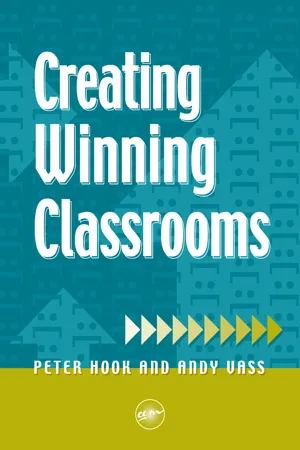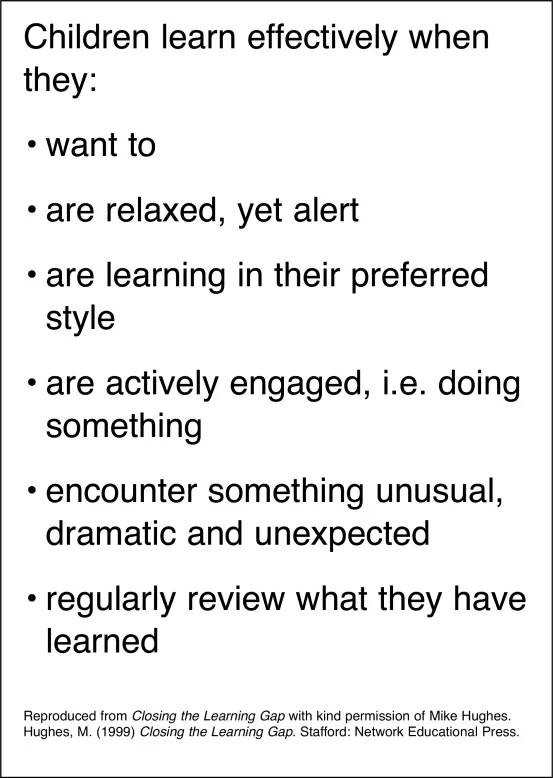![]()
Chapter 1
Setting the Emotional Context
Our evidence suggests that many children who behave badly in school are those whose self-esteem is threatened by failure. They see academic work as competitive and the competition as unwinnable. They soon realise that the best way to avoid failure in such a competition is not to enter it.
The Elton Report
In Confident Classroom Leadership, the emphasis was on the ways in which you can positively influence and effectively manage the behaviour of the students in your classes. Part of this process involved exploring how you could take responsibility for your own behaviour. For example, in how you respond to the choices students make and how you can be proactive in setting and maintaining an agenda which gives both choice and responsibility to the students.
In this book, we will revisit some of the key issues of choices and consequences and develop them further to offer deeper understanding and insights. We will also explore many additional perspectives that contribute to and support your journey towards a ‘winning classroom’.
The quote above from Lord Elton’s 1989 report into discipline in schools makes a clear and still relevant connection between academic study and emotional response in terms of self-esteem and describes by implication, those whose emotions are threatened by school, as losers. You will, we are sure, be familiar with students who still ‘fit’ Elton’s description today.
In writing this book, we made a conscious decision not to focus on what could be described as the curriculum or academic component of classroom life. Clearly, we recognise the requirements and accompanying expectations, indeed pressures, of working within the national agenda of raising achievement. Indeed, we would argue that this book makes a valuable contribution in its own way to that agenda. However, we do not intend to add to the many excellent books that deal with learning styles and accelerated or brain based learning currently in print. We offer instead a list of resources and suggested reading. In particular, we would draw your attention to the work of Mike Hughes. His approach to learning, we believe, makes a valuable contribution towards creating a winning classroom. To illustrate this we have reproduced in Figure 1.1 some of his ideas on the nature of effective learning. However, there are two factors that have influenced our decision to adopt a different perspective – factors that we consider to be of greater significance in creating winning classrooms and that often appear to be overlooked in the debate about successful teaching and learning.
Firstly, there is the mindset that accompanies the word ‘delivery’. In recent years, much emphasis has been placed on ‘delivering the curriculum’. The phrase is used with alarming regularity in connection not only with schemes of work and programmes of study, etc., but also to describe the process of what occurs in classrooms. Our experience of leading training workshops and working with schools on consultancy and support programmes is that many teachers, almost by default, believe that ‘delivering’ the curriculum is a key responsibility and expectation. We disagree! Our belief is that we teach the curriculum and this requires a different set of skills entirely.
As a householder, you will receive deliveries of mail. You may have newspapers and milk delivered too. Our guess is that these are quite incidental transactions in your lives and that, generally speaking, the relationships you have with these people are not significant or meaningful.
It is our view then, that the repeated emphasis on the need to ‘deliver’ the curriculum has tended to obscure the fundamental skills required to build relationships with students thereby creating the platform for a successful classroom climate. Certainly, as those of you who joined us on our Confident Classroom Leadership workshops testified, these skills are not part of Initial Teacher Training. To us, effective teaching and effective learning is about the micro skills of human transactions. The ways we build rapport, seeking to connect intellectually and emotionally with our students, recognising that their experiences and agendas are diverse and having the skill and desire to enter their world, are fundamental to the process of collaborating with them in creating successful and empowering educational experiences. As Mike Hughes (1999) states:
Learning is not done to people. It is done by them.
The second factor comes from the knowledge that exists about effective learning conditions. Recent developments in the understanding of neuroscience have allowed us to become more aware of brain functioning and in particular its significance in how learning occurs. There are many excellent books around now about brain based and accelerated learning and their effect in the classroom. All of them explore the impact of the emotional climate or ‘learner state’ as a vital component in effective learning. The emotional climate is directly conditioned by the quality of the relationships that exist in class.
The physical environment of the classroom will clearly impact on students’ ability to learn as will, of course, the way the intellectual learning is structured. However, neither of these factors have as much influence as the emotional climate of your classroom. In situations where a student feels or perceives a degree of threat or negative stress, their ability to learn is greatly impaired. Dr Brian Boyd, writing in the TES (May 1997), suggested that we need to ‘focus on the attitudes, motivation and self-esteem of young people’.
Put simply, what students think about their ability to learn, the climate in which they are asked to learn, the way they feel about themselves and their relationships with you and each other are too significant to be left to chance.
Our view may be simplistic but we challenge you to consider the context in which increasing numbers of students can be described as ‘losers’ in our educational setting. At no other time has greater concern been expressed about students who are variously described as ‘demotivated’, ‘disaffected’ or ‘ underachieving’ in some way, while the Government’s Social Inclusion agenda seeks to repair the widespread damage of missed educational opportunity.
A key theme in Confident Classroom Leadership was the degree to which you were able to acknowledge and accept responsibility for your own behaviour and recognise what aspects of classroom life were within your circle of influence. In creating a winning classroom, the basis of the question remains the same. In what ways can you proactively influence and teach the emotional curriculum in your class so that your students are able to feel that they can become winners?
In summary, we would like to remind you of one of Aesop’s fables about the goose that laid golden eggs, an analogy we will expand on later in the book. We see academic success in its broadest sense to be the golden egg to which all those in education aspire. However, if the goose is not nurtured and maintained in a healthy and supportive way, eventually the goose will die and there will be no more golden eggs. If we want our students to not only learn intellectually but also develop healthy emotional intelligence, then we must proactively spend time maintaining the climate in which this can take place.
Key Points
- Ignoring emotions inhibits the learning climate
- A wealth of information exists about learning
- We teach the curriculum
- Teaching is about interpersonal transactions
- Students need to be in the correct emotional state before learning can be effective
- The emotional climate of the classroom is significantly within your circle of influence
- Winning classrooms have proactive approaches to empowering emotional climates
Figure 1.1
Questions for Professional Development
What do you feel about the topics covered in this chapter?
What are some of the implications of the topics within your classroom?
What is it most important to you to remember from this chapter?
![]()
Chapter 2
Creating an Emotionally Intelligent Classroom
Your success as an educator is more dependent on positive, caring, trustworthy relationships than on any skill, idea, tip or tool.
Eric Jensen
As we said in the Introduction, this book is about the emotional climate of classrooms. In this chapter we consider the significance of emotions in successful teaching by offering a introduction to the notion of emotional intelligence and exploring two other key components we feel contribute to an emotionally empowering classroom.
In some form you are likely to spend a reasonable amount of time planning lessons, organising what you are going to teach, how you are going to teach it, what resources you require and so on. It is also likely your plan will include some idea or vision of what you want your students to achieve. In Confident Classroom Leadership we stressed the importance of including in your plans the concept of planning for good behaviour too. In other words, positive behaviour was too important a factor in successful teaching to be left to chance. This planning process is a natural way of creating action steps towards your goal or desired outcome for your students.
In this chapter we make the case for a further dimension to that planning – a consideration of emotional development. We do this not to add additional burden but for the simple reason that again, it is too important to be left to chance. The emotional climate of your classroom will either support or inhibit students in their journey towards academic and social growth and learning.
Classrooms are emotionally complex and dynamic organisations and as with all human activities involving human interaction, nobody can offer definite guidelines on how to cater for every situation. However, the insights and understandings we offer here and throughout the book, build carefully from Confident Classroom Leadership to provide you with developing awareness as to the significance and impact of your role in contributing to an emotionally empowering classroom.
Emotional Intelligence
Peter Salovey, a Harvard psychologist, first used the phrase ‘emotional intelligence’ in 1989 to describe a range of skills and qualities he felt were significant factors in success. He included the following:
- a conscious understanding of feelings
- how to effectively manage those feelings in socially appropriate ways
- empathy
- responsibility and self-motivation
- an ability to resolve interpersonal issues.
He defined emotional intelligence as,
the ability to monitor one’s own and others’ feelings and emotions, to discriminate among them and to use this information to guide one’s thinking and actions.
Daniel Goleman’s best seller in 1996, Emotional Intelligence, which described a range of studies and research issues, was one of the first books to raise awareness widely about the significance of emotions. It made the point that emotions were not just intangible things that happened but chemical and neurological responses essential for both survival and well-being.
The significance and challenge for us as teachers is that Goleman cites studies which suggest that emotional intelligence or EQ is a more accurate predictor of success than academic intelligence or IQ. He states that,
At best IQ contributes about 20 per cent to the factors that determine life success.
As a...

